Research on the Warping and Dross Formation of an Overhang Structure Manufactured by Laser Powder Bed Fusion
Abstract
1. Introduction
2. Materials and Methods
2.1. Experiment Methods
2.2. Heat Transfer Model
2.3. Stress Model
- The yield deformation process of the material obeys the von Mises yield principle;
- The volume of the material remains when plastic deformation occurs;
- The material follows both the flow rule and the bilinear strengthening rule during the plastic deformation;
- The mechanical properties of the material are in a linear relationship with the stress and strain in a small increment of time;
- The entire powder layer is assumed to melt at once instead of in a track−by−track fashion.
2.4. Physical Description of the Mode
2.5. Material Properties of AlSi10Mg
3. Results and Discussion
3.1. Experiment Result
3.2. Temperature Analysis
3.3. Dross Formation Process
3.4. Deformation Analysis
3.5. Residual Stress Analysis
3.6. Warping Process
4. Conclusions
- The different thermal conductivity between the powder and solid support zone leads to the difference in the molten pool size, which is the main reason for the appearance of dross formation. The simulation result showed that when the laser scanned the powder support zone, the temperature difference between the two regions reached approximately 900 °C, causing the size of molten pool to increase significantly. The molten pool sank due to the actions of gravity and the capillary force, leading to the droplet−like dross formation on the lower surface beyond the designed shape area. With the increase in the number of forming layers, each formed layer plays a role in heat conduction; therefore, the difference becomes smaller and smaller;
- The main reason for warping deformation is that when manufacturing commences, the overhang structure has no constraint; therefore, plastic deformation occurs when the residual stress exceeds the strength of the material. This leads to a low residual stress zone at the edge of overhang area. This deformation affects the subsequent powder spreading process, which makes the warping area exist in a state of remelting. As the number of forming layers increases, the stiffness of the overhang structure increases as well, and the warping deformation gradually decreases;
- In the forming process, the warpage at the top of the parts that can be formed will continue to decrease. The results of the experiment showed that the top warpage reduced to zero for groups 1–6 (2 mm length) with a 1.2 mm (40 layers) height, groups 7–12 (2.5 mm length) with a 1.8 mm (60 layers) height, and groups 13–18 (3 mm length) with a 2.4 mm (80 layers) height. During the simulation process, as the number of forming layers increased, the deformation of the top area decreased from 28.5 μm to 9.18 μm, and the warpage of the parts increased from 2.44 μm to 56.1 μm. These values indicate that with the increase in the number of manufacturing layers, the overall warping of the parts also increased, while the top warping gradually decreased.
Author Contributions
Funding
Institutional Review Board Statement
Informed Consent Statement
Data Availability Statement
Conflicts of Interest
References
- Bo, Q.; Yu-Sheng, S.; Qing-Song, W.; Hai-Bo, W. The helix scan strategy applied to the selective laser melting. Int. J. Adv. Manuf. Technol. 2012, 63, 631–640. [Google Scholar] [CrossRef]
- Xie, D.; Zhao, J.; Liang, H.; Shen, L.; Tian, Z.; Ahsan, N.; Song, Y.; Xiao, M. Comprehension of overhanging structure distortion via selective laser melting based on theory of constraining force induced distortion. In Proceedings of the 17th International Bhurban Conference on Applied Sciences and Technology (IBCAST), Islamabad, Pakistan, 14–18 January 2020; pp. 1–4. [Google Scholar]
- Atzeni, E.; Salmi, A. Study on unsupported overhangs of AlSi10Mg parts processed by Direct Metal Laser Sintering (DMLS). J. Manuf. Process. 2015, 20, 500–506. [Google Scholar] [CrossRef]
- Li, L.; Pan, T.; Zhang, X.; Chen, Y.; Cui, W.; Yan, L.; Liou, F. Deformations and stresses prediction of cantilever structures fabricated by selective laser melting process. Rapid Prototyp. J. 2021, 27, 453–464. [Google Scholar] [CrossRef]
- Lin, H.-Y.; Tran, H.-C.; Lo, Y.-L.; Le, T.-N.; Chiu, K.-C.; Hsu, Y.-Y. Optimization of Surface Roughness and Density of Overhang Structures Fabricated by Laser Powder Bed Fusion. 3D Print. Addit. Manuf. 2022. [Google Scholar] [CrossRef]
- Zhao, J.; Xie, D.; Liang, H.; Xiao, M.; Shen, L.; Tian, Z. Review of Distortion and Residual Stress in Metal Additive Manufacturing. J. Nanjing Univ. Aeronaut. Astronaut. 2019, 51, 1–6. [Google Scholar] [CrossRef]
- Kruth, J.P.; Froyen, L.; Vaerenbergh, J.V.; Mercelis, P.; Rombouts, M.; Lauwers, B. Selective laser melting of iron-based powder. J. Mater. Process. Technol. 2004. [Google Scholar] [CrossRef]
- Charles, A.; Elkaseer, A.; Paggi, U.; Thijs, L.; Hagenmeyer, V.; Scholz, S. Down-facing surfaces in laser powder bed fusion of Ti6Al4V: Effect of dross formation on dimensional accuracy and surface texture. Addit. Manuf. 2021, 46, 102148. [Google Scholar] [CrossRef]
- Jia, H.; Sun, H.; Wang, H.; Wu, Y.; Wang, H. Scanning strategy in selective laser melting (SLM): A review. Int. J. Adv. Manuf. Technol. 2021, 113, 2413–2435. [Google Scholar] [CrossRef]
- Wang, D.; Yang, Y.; Yi, Z.; Su, X. Research on the fabricating quality optimization of the overhanging surface in SLM process. Int. J. Adv. Manuf. Technol. 2013, 65, 1471–1484. [Google Scholar] [CrossRef]
- Duan, W.; Han, J.; Xia, Q.; Wang, K.; Wu, M.; Song, D. Investigation on the relationship between bending angle of the overhanging surface and overhanging surface quality printed using selective laser melting. Rapid Prototyp. J. 2021, 27, 1573–1579. [Google Scholar] [CrossRef]
- Ossola, E.; Shapiro, A.A.; Pate, A.; Firdosy, S.; Brusa, E.; Sesana, R. Fabrication defects and limitations of AlSi10Mg lattice structures manufactured by selective laser melting. Proc. Inst. Mech. Eng. Part L J. Mater. Des. Appl. 2021, 235, 2071–2082. [Google Scholar] [CrossRef]
- Vora, P.; Mumtaz, K.; Todd, I.; Hopkinson, N. AlSi12 in-situ alloy formation and residual stress reduction using anchorless selective laser melting. Addit. Manuf. 2015, 7, 12–19. [Google Scholar] [CrossRef]
- Vasileska, E.; Demir, A.G.; Colosimo, B.M.; Previtali, B. A novel paradigm for feedback control in LPBF: Layer-wise correction for overhang structures. Adv. Manuf. 2022, 10, 326–344. [Google Scholar] [CrossRef]
- Ma, Z.; Gao, M.; Guo, K.; Wang, Q.; Li, L.; Liu, C.; Zhu, G.; Liu, Z. Analysis and Optimization of Energy Consumption for Multi-part Printing Using Selective Laser Melting and Considering the Support Structure. Int. J. Precis. Eng. Manuf. Technol. 2022, 1–15. [Google Scholar] [CrossRef]
- Yadroitsev, I.; Shishkovsky, I.; Bertrand, P.; Smurov, I. Manufacturing of fine-structured 3D porous filter elements by selective laser melting. Appl. Surf. Sci. 2009, 255, 5523–5527. [Google Scholar] [CrossRef]
- Ameen, W.; Al-Ahmari, A.; Mohammed, M.K. Self-supporting overhang structures produced by additive manufacturing through electron beam melting. Int. J. Adv. Manuf. Technol. 2019, 104, 2215–2232. [Google Scholar] [CrossRef]
- Oter, Z.C.; Coskun, M.; Akca, Y.; Surmen, O.; Yilmaz, M.S.; Ozer, G.; Tarakci, G.; Khan, H.M.; Koc, E. Support optimization for overhanging parts in direct metal laser sintering. Optik 2019, 181, 575–581. [Google Scholar] [CrossRef]
- Kappes, B.; Moorthy, S.; Drake, D.; Geerlings, H.; Stebner, A. Machine learning to optimize additive manufacturing parameters for laser powder bed fusion of Inconel 718. In Proceedings of the 9th International Symposium on Superalloy 718 and Derivatives-Energy, Aerospace, and Industrial Applications, Champion, PA, USA, 17–21 September 2000; pp. 595–610. [Google Scholar]
- Gu, D.; Yang, J.; Wang, H.; Lin, K.; Yuan, L.; Hu, K.; Wu, L. Laser powder bed fusion of bio-inspired reticulated shell structure: Optimization mechanisms of structure, process, and compressive property. CIRP J. Manuf. Sci. Technol. 2021, 35, 1–12. [Google Scholar] [CrossRef]
- Han, Q.; Gu, H.; Soe, S.; Setchi, R.; Lacan, F.; Hill, J. Manufacturability of AlSi10Mg overhang structures fabricated by laser powder bed fusion. Mater. Des. 2018, 160, 1080–1095. [Google Scholar] [CrossRef]
- Le, K.; Wong, C.; Chua, K.; Tang, C.; Du, H. Discontinuity of overhanging melt track in selective laser melting process. Int. J. Heat Mass Transf. 2020, 162, 120284. [Google Scholar] [CrossRef]
- Yadroitsev, I.; Yadroitsava, I. Evaluation of residual stress in stainless steel 316L and Ti6Al4V samples produced by selective laser melting. Virtual Phys. Prototyp. 2015, 10, 67–76. [Google Scholar] [CrossRef]
- Zhang, J.; Song, B.; Wei, Q.; Bourell, D.; Shi, Y. A review of selective laser melting of aluminum alloys: Processing, microstructure, property and developing trends. J. Mater. Sci. Technol. 2019, 35, 270–284. [Google Scholar] [CrossRef]
- Brika, S.E.; Letenneur, M.; Dion, C.A.; Brailovski, V. Influence of particle morphology and size distribution on the powder flowability and laser powder bed fusion manufacturability of Ti-6Al-4V alloy. Addit. Manuf. 2020, 31, 100929. [Google Scholar] [CrossRef]
- Liu, B.; Li, B.-Q.; Li, Z.; Bai, P.; Wang, Y.; Kuai, Z. Numerical investigation on heat transfer of multi-laser processing during selective laser melting of AlSi10Mg. Results Phys. 2019, 12, 454–459. [Google Scholar] [CrossRef]
- Liu, S.; Zhu, H.; Peng, G.; Yin, J.; Zeng, X. Microstructure prediction of selective laser melting AlSi10Mg using finite element analysis. Mater. Des. 2018, 142, 319–328. [Google Scholar] [CrossRef]
- Huang, Y.; Yang, L.; Du, X.; Yang, Y. Finite element analysis of thermal behavior of metal powder during selective laser melting. Int. J. Therm. Sci. 2016, 104, 146–157. [Google Scholar] [CrossRef]
- Lewis, R.W.; Nithiarasu, P.; Seetharamu, K.N. Fundamentals of the Finite Element Method for Heat and Fluid Flow; John Wiley & Sons: Hoboken, NJ, USA, 2004. [Google Scholar]
- Dai, K.; Shaw, L. Finite element analysis of the effect of volume shrinkage during laser densification. Acta Mater. 2005, 53, 4743–4754. [Google Scholar] [CrossRef]
- Pei, W.; Zhengying, W.; Zhen, C.; Junfeng, L.; Shuzhe, Z.; Jun, D. Numerical simulation and parametric analysis of selective laser melting process of AlSi10Mg powder. Appl. Phys. A-Mater. Sci. Process. 2017, 123, 540. [Google Scholar] [CrossRef]
- Yin, J.; Zhu, H.; Ke, L.; Hu, P.; He, C.; Zhang, H.; Zeng, X. A finite element model of thermal evolution in laser micro sintering. Int. J. Adv. Manuf. Technol. 2016, 83, 1847–1859. [Google Scholar] [CrossRef]
- Zhang, X.; Wang, J.; Kang, J.; Rong, Y.; Duan, G.; Wu, P.; Zheng, L. The dynamic arch bending mechanism of flat bridge structure of AlSi10Mg during SLM process. Mater. Des. 2020, 188, 108469. [Google Scholar] [CrossRef]
- Liu, S.; Zhu, J.; Zhu, H.; Yin, J.; Chen, C.; Zeng, X. Effect of the track length and track number on the evolution of the molten pool characteristics of SLMed Al alloy: Numerical and experimental study. Opt. Laser Technol. 2020, 123, 105924. [Google Scholar] [CrossRef]
- Aboulkhair, N.T.; Everitt, N.M.; Ashcroft, I.; Tuck, C. Reducing porosity in AlSi10Mg parts processed by selective laser melting. Addit. Manuf. 2014, 1, 77–86. [Google Scholar] [CrossRef]
- Foroozmehr, A.; Badrossamay, M.; Foroozmehr, E.; Golabi, S. Finite Element Simulation of Selective Laser Melting process considering Optical Penetration Depth of laser in powder bed. Mater. Des. 2016, 89, 255–263. [Google Scholar] [CrossRef]
- Wu, J.; Wang, L.; An, X. Numerical analysis of residual stress evolution of AlSi10Mg manufactured by selective laser melting. Optik 2017, 137, 65–78. [Google Scholar] [CrossRef]
- Wang, L.; Jiang, X.; Zhu, Y.; Zhu, X.; Sun, J.; Yan, B. An approach to predict the residual stress and distortion during the selective laser melting of AlSi10Mg parts. Int. J. Adv. Manuf. Technol. 2018, 97, 3535–3546. [Google Scholar] [CrossRef]
- Xiaohui, J.; Chunbo, Y.; Honglan, G.; Shan, G.; Yong, Z. Effect of supporting structure design on residual stresses in selective laser melting of AlSi10Mg. Int. J. Adv. Manuf. Technol. 2022, 118, 1597–1608. [Google Scholar] [CrossRef]
- Jiang, X.; Xiong, W.; Wang, L.; Guo, M.; Ding, Z. Heat treatment effects on microstructure-residual stress for selective laser melting AlSi10Mg. Mater. Sci. Technol. 2020, 36, 168–180. [Google Scholar] [CrossRef]
- Wu, F.; Sun, Z.; Chen, W.; Liang, Z. The Effects of Overhang Forming Direction on Thermal Behaviors during Additive Manufacturing Ti-6Al-4V Alloy. Materials 2021, 14, 3749. [Google Scholar] [CrossRef]
- Liu, Y.; Yang, Y.; Mai, S.; Wang, D.; Song, C. Investigation into spatter behavior during selective laser melting of AISI 316L stainless steel powder. Mater. Des. 2015, 87, 797–806. [Google Scholar] [CrossRef]
- Liu, Y.; Yang, Y.; Wang, D. A study on the residual stress during selective laser melting (SLM) of metallic powder. Int. J. Adv. Manuf. Technol. 2016, 87, 647–656. [Google Scholar] [CrossRef]
- Jun, S.; Qian, T.; Qixiang, F.; Shuai, M.; Quanquan, H.; Setchi, R. Effect of Remelting Process on Surface Quality and Tensile Behaviour of a Maraging Steel Manufactured by Selective Laser Melting; Springer: Singapore, 2021; pp. 251–260. [Google Scholar]
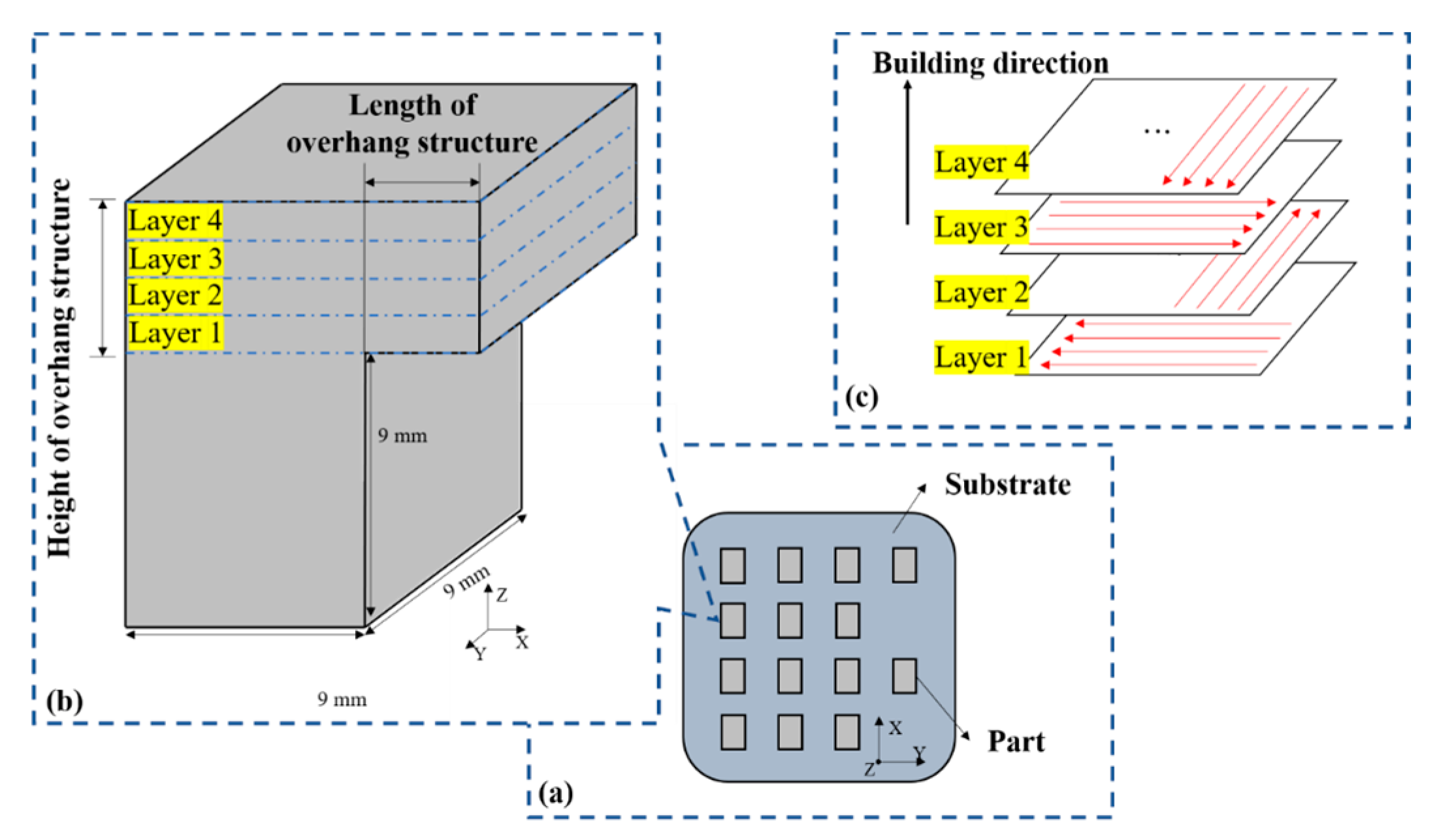

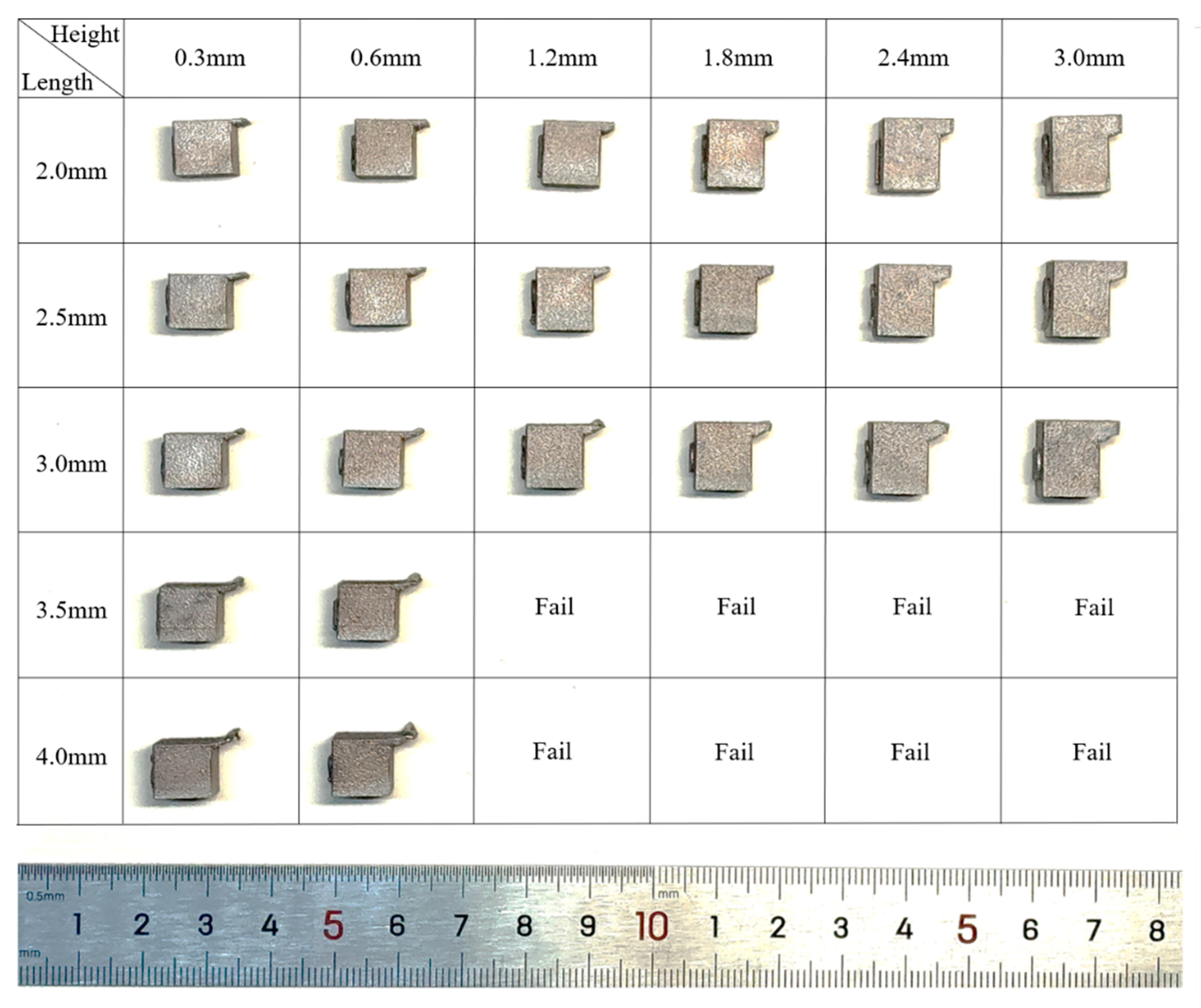
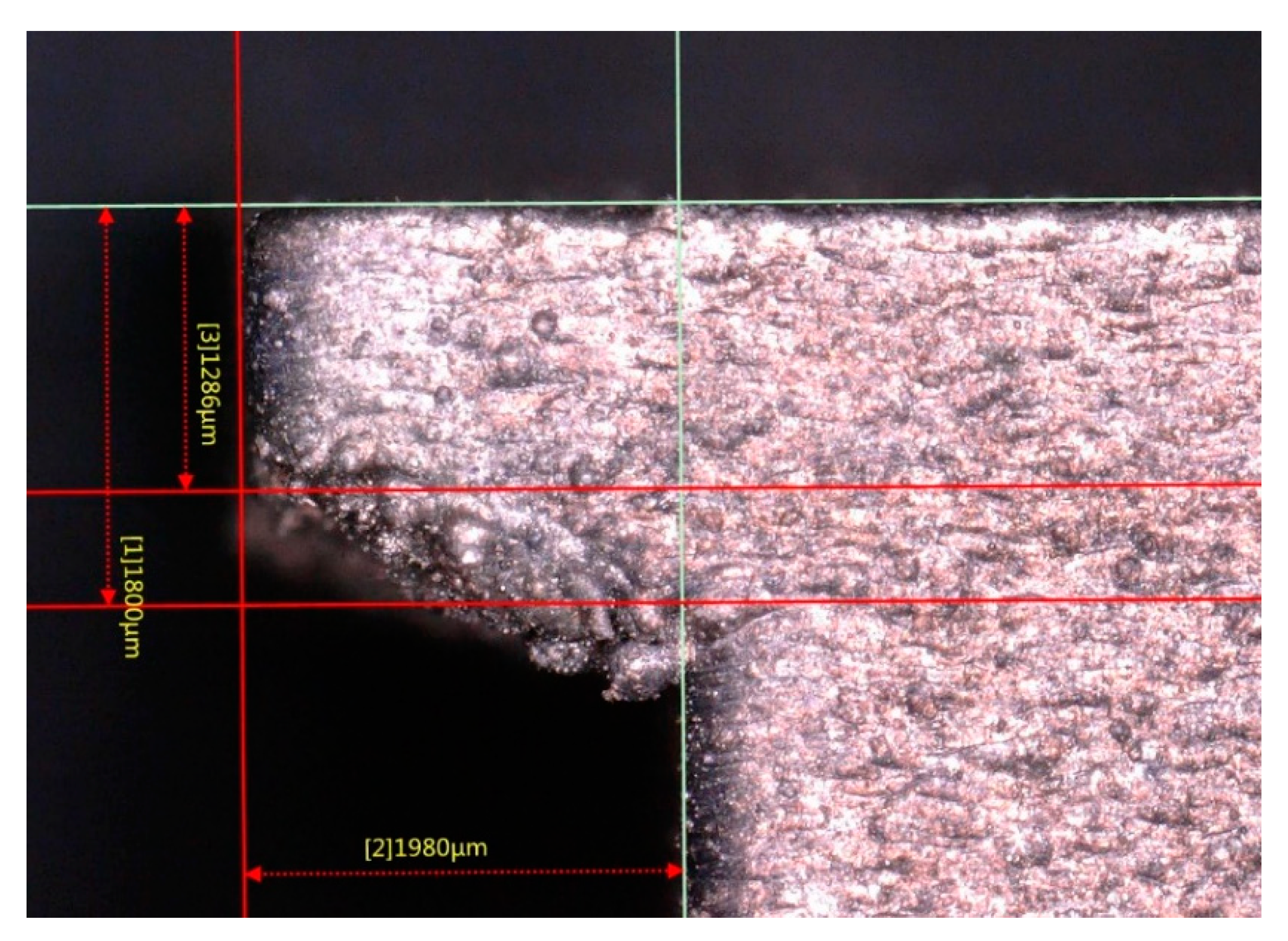
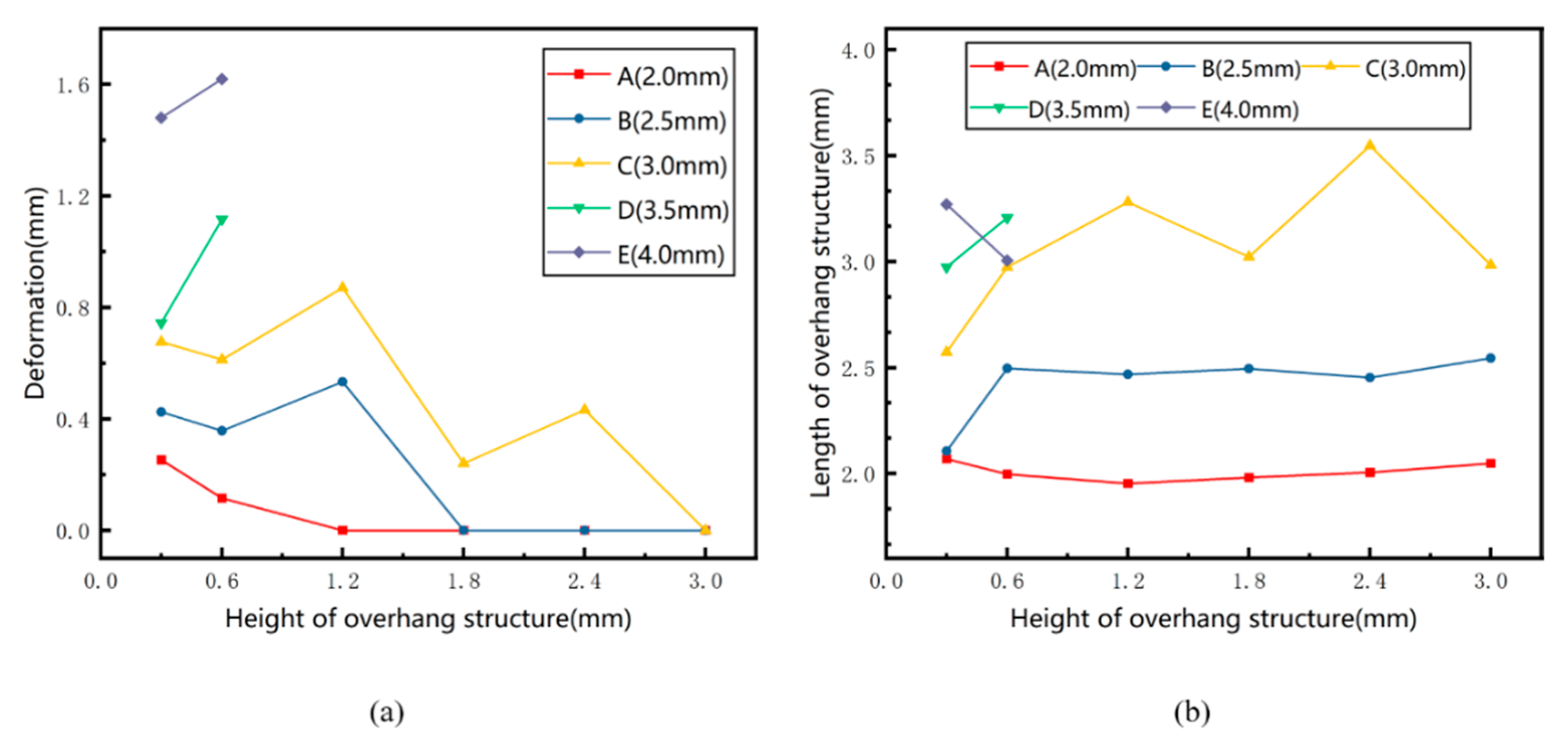
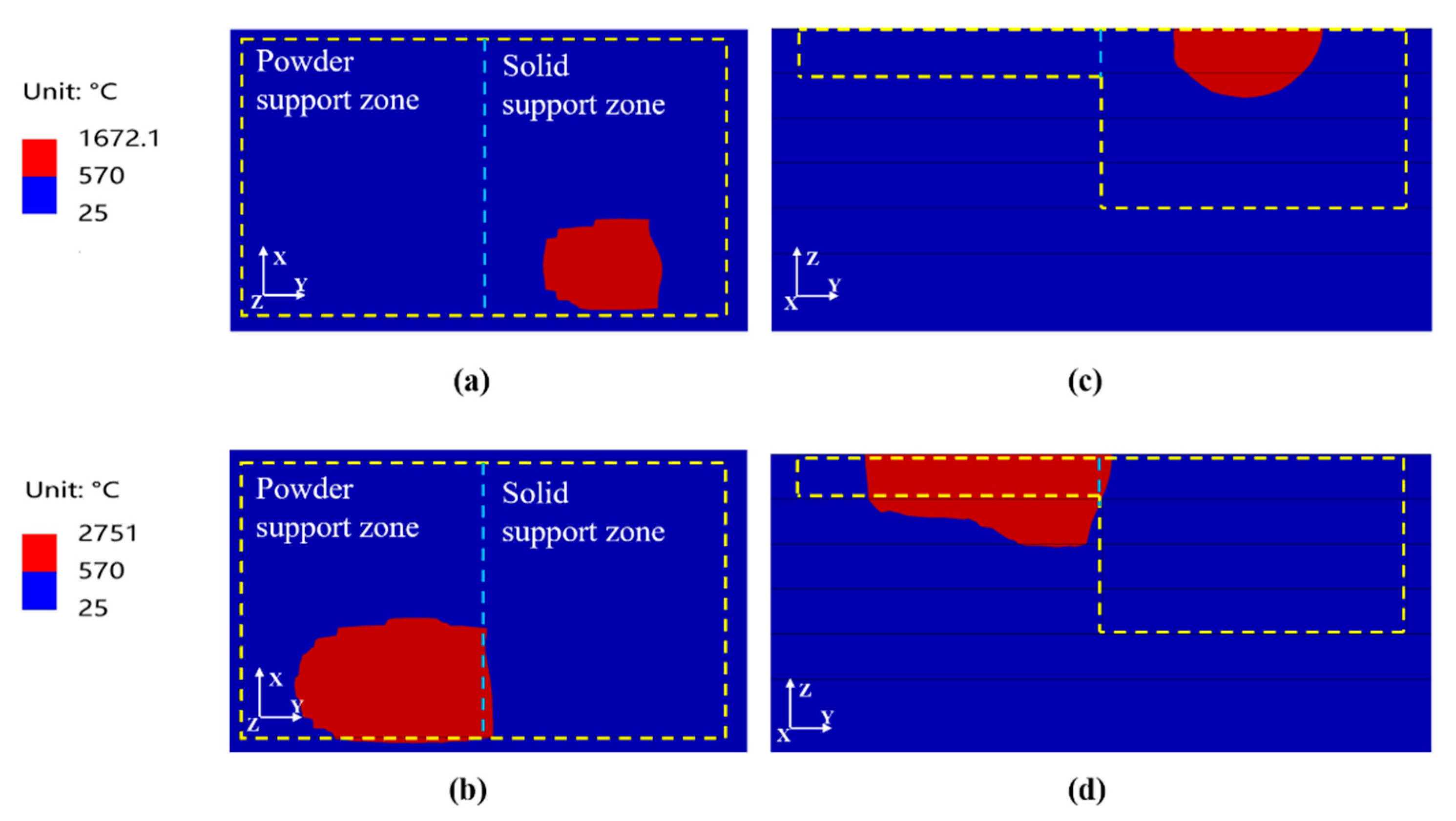

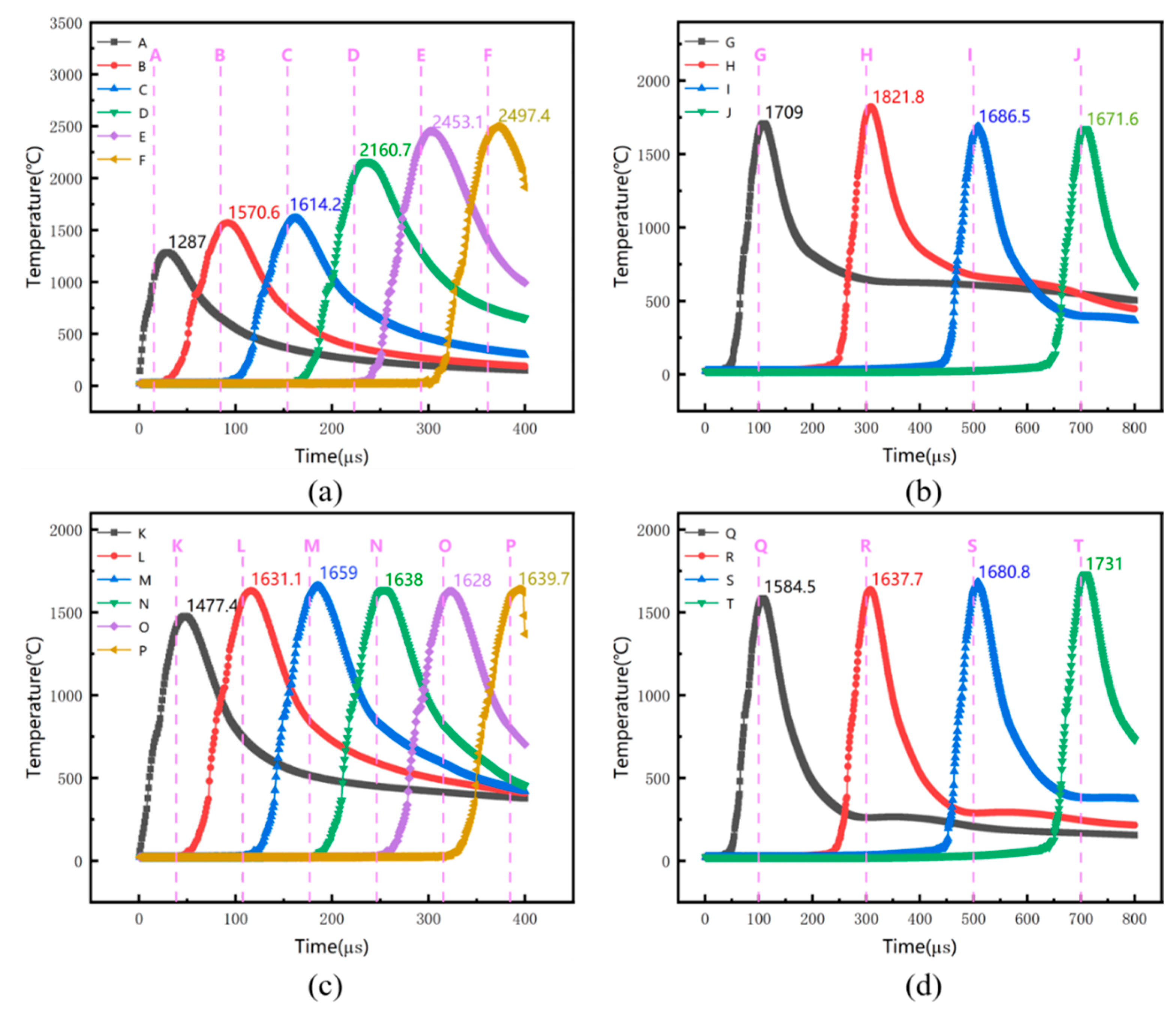

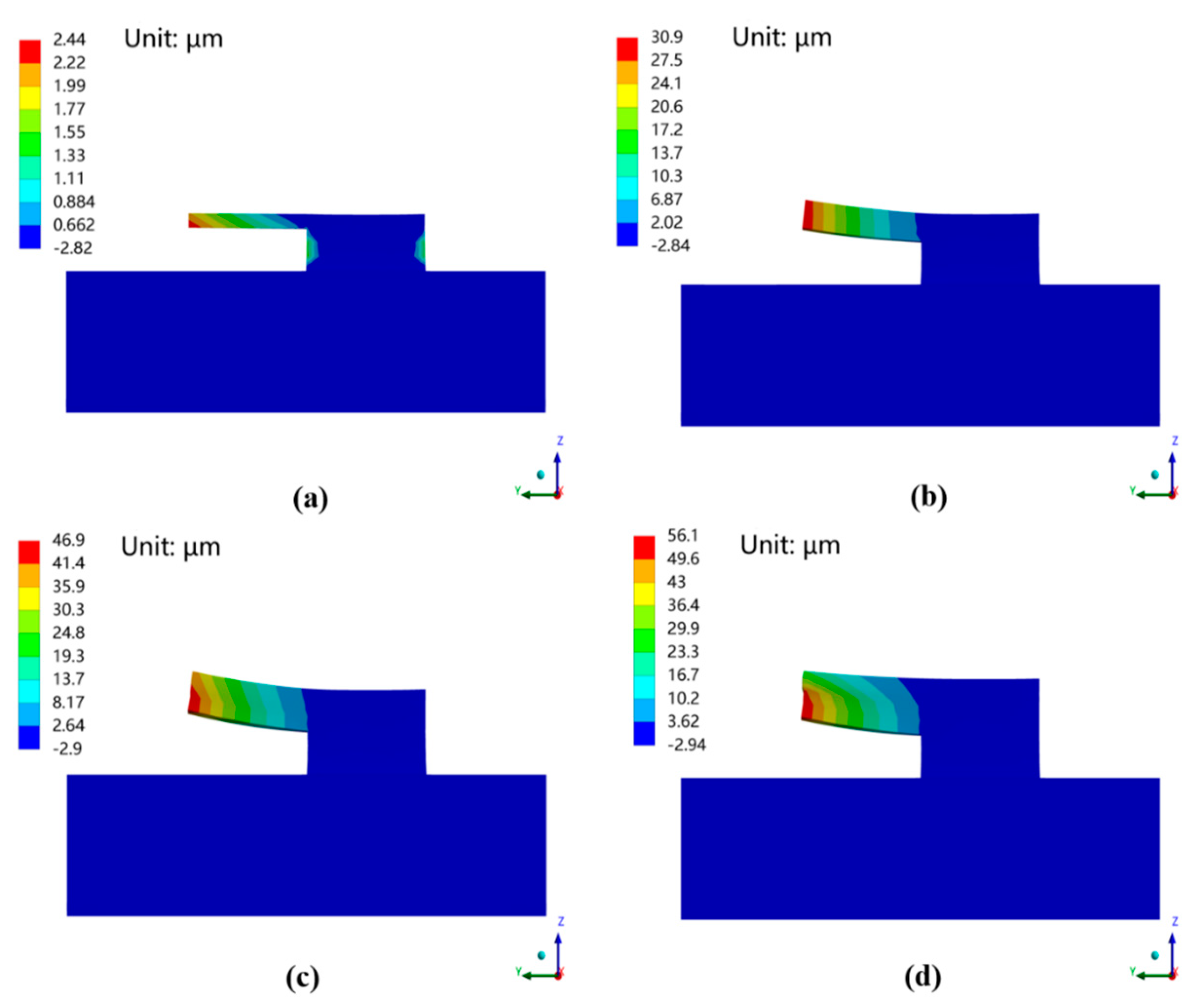
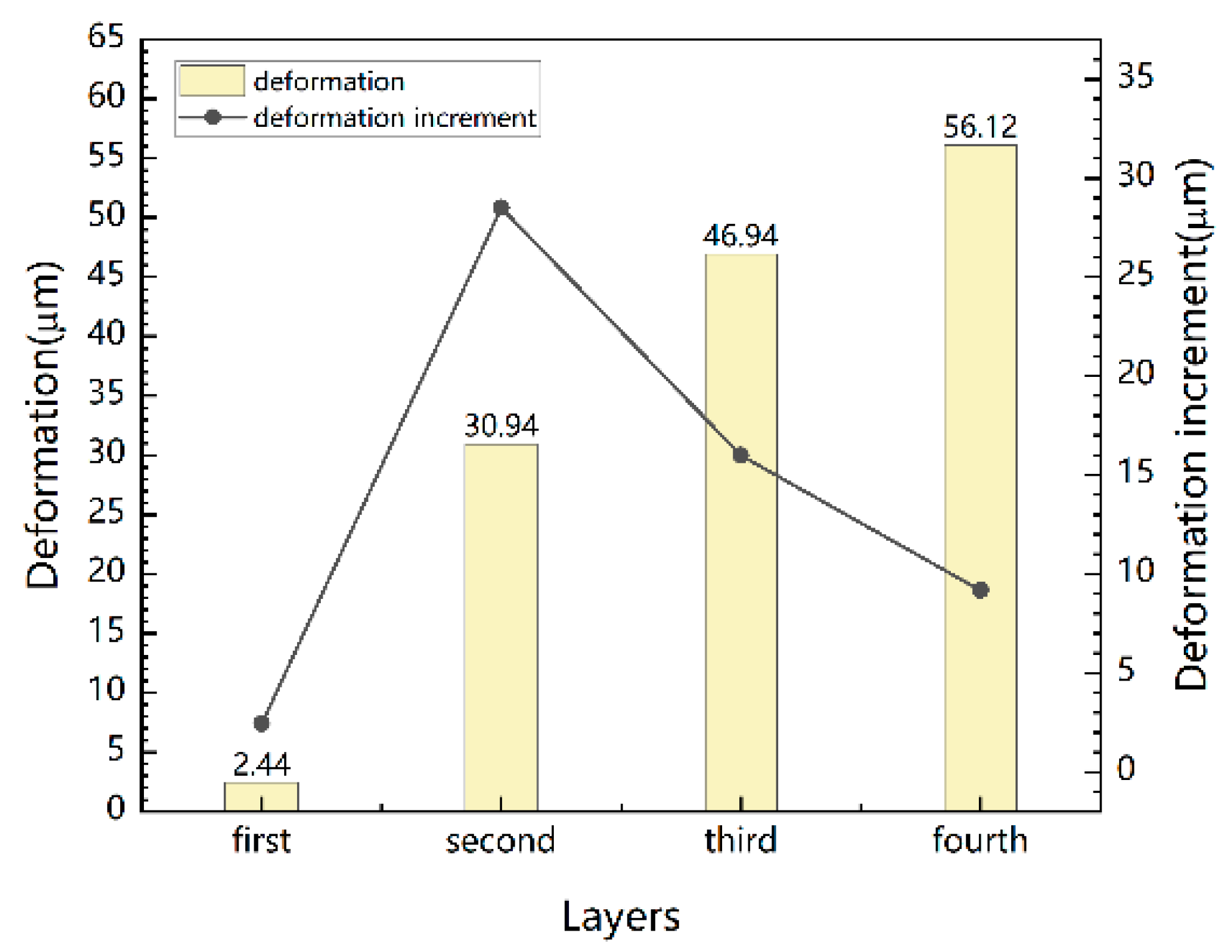
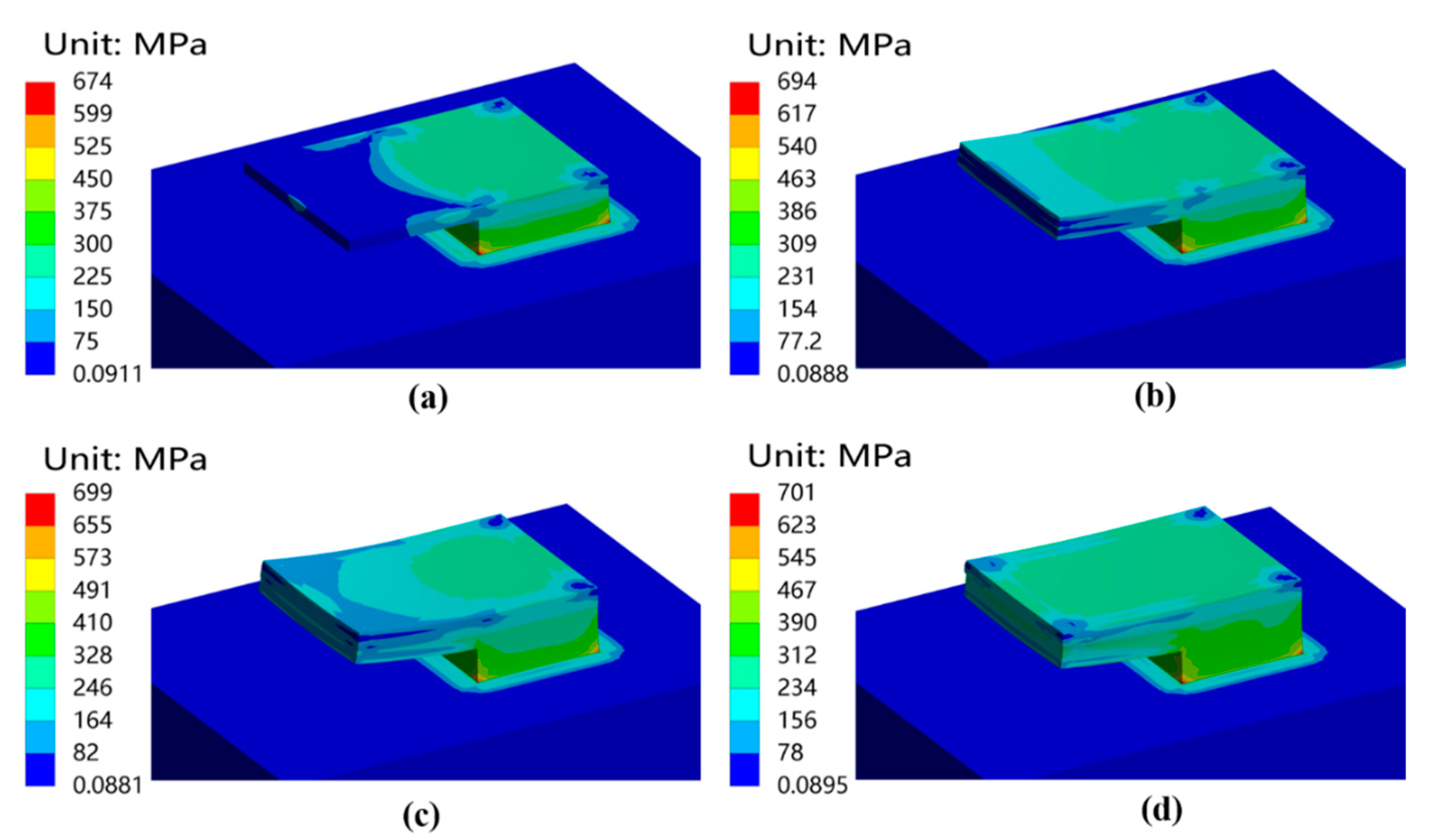
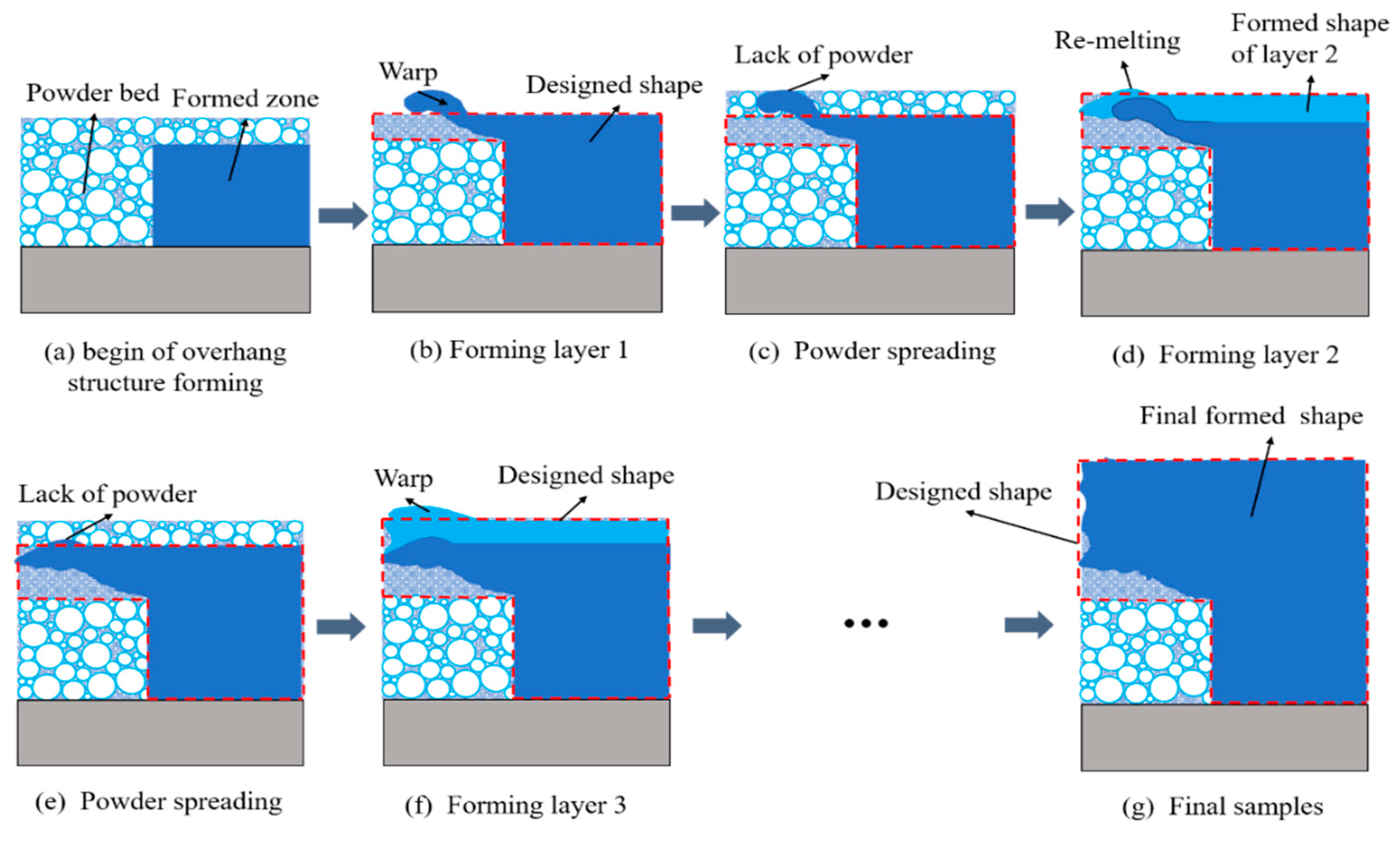
| Al | Si | Mg | Fe | Mn | Zn | Ni |
|---|---|---|---|---|---|---|
| Balance | 9.66 | 0.42 | 0.10 | 0.2 | <0.01 | 0.02 |
| Trial | Length of Overhang Structure (mm) | Laser Power (W) | Beam Diameter (mm) | Layer Thickness (mm) | Hatch Spacing (mm) | Scan Speed (m/s) | Scan Strategy |
|---|---|---|---|---|---|---|---|
| 1–6 | 2.0 | 300 | 0.1 | 0.03 | 0.13 | 1.3 | 90° rotation |
| 7–12 | 2.5 | 300 | 0.1 | 0.03 | 0.13 | 1.3 | 90° rotation |
| 13–18 | 3.0 | 300 | 0.1 | 0.03 | 0.13 | 1.3 | 90° rotation |
| 19–24 | 3.5 | 300 | 0.1 | 0.03 | 0.13 | 1.3 | 90° rotation |
| 25–30 | 4.0 | 300 | 0.1 | 0.03 | 0.13 | 1.3 | 90° rotation |
| 31–36 | 4.5 | 300 | 0.1 | 0.03 | 0.13 | 1.3 | 90° rotation |
| 37–42 | 5.0 | 300 | 0.1 | 0.03 | 0.13 | 1.3 | 90° rotation |
| Temperature (°C) | 20 | 120 | 320 | 520 | 820 | 1120 |
|---|---|---|---|---|---|---|
| Density (kg/m3) | 2660 | 2643 | 2606 | 2568 | 2374 | 2266 |
| Thermal conductivity (W/(m·K)) | 150 | 144 | 130 | 120 | 107 | 63 |
| Specific heat capacity (J/(kg·K)) | 700 | 748 | 848 | 1066 | 922 | 925 |
| Density (powder) (kg/m3) | 1596 | 1586 | 1563 | 1541 | − | − |
| Thermal conductivity (powder) (W/(m·K)) | 1.5 | 1.4 | 1.3 | 1.2 | − | − |
| Specific heat capacity (powder) (J/(kg·K)) | 420 | 449 | 509 | 1066 | − | − |
| Coefficient of thermal expansion (10−6/K) | 21.7 | 21.8 | 31.4 | 20.6 | − | − |
| Young’s modulus (GPa) | 76 | 72 | 64 | 52 | 0 | 0 |
| Poisson’s ratio | 0.32 | 0.33 | 0.34 | 0.36 | 0.5 | 0.5 |
| Yield strength (MPa) | 250 | 150 | 105 | 70 | − | − |
| Latent heat (J/kg) | 3.9 × 105 | |||||
Disclaimer/Publisher’s Note: The statements, opinions and data contained in all publications are solely those of the individual author(s) and contributor(s) and not of MDPI and/or the editor(s). MDPI and/or the editor(s) disclaim responsibility for any injury to people or property resulting from any ideas, methods, instructions or products referred to in the content. |
© 2023 by the authors. Licensee MDPI, Basel, Switzerland. This article is an open access article distributed under the terms and conditions of the Creative Commons Attribution (CC BY) license (https://creativecommons.org/licenses/by/4.0/).
Share and Cite
Lin, P.; Wang, M.; Trofimov, V.A.; Yang, Y.; Song, C. Research on the Warping and Dross Formation of an Overhang Structure Manufactured by Laser Powder Bed Fusion. Appl. Sci. 2023, 13, 3460. https://doi.org/10.3390/app13063460
Lin P, Wang M, Trofimov VA, Yang Y, Song C. Research on the Warping and Dross Formation of an Overhang Structure Manufactured by Laser Powder Bed Fusion. Applied Sciences. 2023; 13(6):3460. https://doi.org/10.3390/app13063460
Chicago/Turabian StyleLin, Pengcheng, Meng Wang, Vyacheslav A. Trofimov, Yongqiang Yang, and Changhui Song. 2023. "Research on the Warping and Dross Formation of an Overhang Structure Manufactured by Laser Powder Bed Fusion" Applied Sciences 13, no. 6: 3460. https://doi.org/10.3390/app13063460
APA StyleLin, P., Wang, M., Trofimov, V. A., Yang, Y., & Song, C. (2023). Research on the Warping and Dross Formation of an Overhang Structure Manufactured by Laser Powder Bed Fusion. Applied Sciences, 13(6), 3460. https://doi.org/10.3390/app13063460







